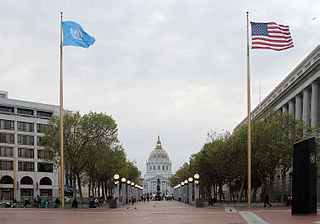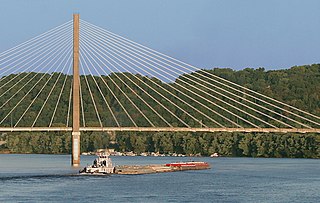
Huntington is a city in Cabell and Wayne counties in the U.S. state of West Virginia. The seat of Cabell County, the city is located in SW West Virginia at the confluence of the Ohio and Guyandotte rivers. Huntington is the second-most populous city in West Virginia, with a population of 46,842 as of the 2020 census. Its metro area, the Huntington–Ashland metropolitan area, is the largest in West Virginia, spanning seven counties across three states and having a population of 376,155 at the 2020 census.

Collis Potter Huntington was an American industrialist and railway magnate. He was one of the Big Four of western railroading who invested in Theodore Judah's idea to build the Central Pacific Railroad as part of the first U.S. transcontinental railroad. Huntington helped lead and develop other major interstate lines, such as the Southern Pacific Railroad and the Chesapeake & Ohio Railway (C&O), which he was recruited to help complete. The C&O, completed in 1873, fulfilled a long-held dream of Virginians of a rail link from the James River at Richmond to the Ohio River Valley. The new railroad facilities adjacent to the river there resulted in expansion of the former small town of Guyandotte, West Virginia into part of a new city which was named Huntington in his honor.

The Civic Center in San Francisco, California, is an area located a few blocks north of the intersection of Market Street and Van Ness Avenue that contains many of the city's largest government and cultural institutions. It has two large plazas and a number of buildings in classical architectural style. The Bill Graham Civic Auditorium, the United Nations Charter was signed in the Veterans Building's Herbst Theatre in 1945, leading to the creation of the United Nations. It is also where the 1951 Treaty of San Francisco was signed. The San Francisco Civic Center was designated a National Historic Landmark in 1987 and listed in the National Register of Historic Places on October 10, 1978.

Marshall University is a public research university in Huntington, West Virginia, United States. It was founded in 1837 and is named after John Marshall, the fourth Chief Justice of the United States. The university is classified among "R2: Doctoral Universities – High research activity".

The Nauvoo Temple was the second temple constructed by the Church of Jesus Christ of Latter Day Saints. The church's first temple was completed in Kirtland, Ohio, United States, in 1836. In the winter of 1846, when the main body of the church was forced out of Nauvoo, the church attempted to sell the building, finally succeeding in 1848. The building was damaged by arson and a tornado before being demolished.

Old Main is the oldest building on the University of Arkansas campus in Fayetteville, Arkansas. It is one of the most recognizable symbols of the University, and of higher education in general in Arkansas.

The East Huntington Bridge is a 900-foot (270 m) cable-stayed bridge crossing the Ohio River at Huntington, West Virginia. It carries West Virginia Route 106 on the West Virginia approach and OH 775 on the Ohio approach.
The main campus of Virginia Tech is located in Blacksburg, Virginia; the central campus is roughly bordered by Prices Fork Road to the northwest, Plantation Road to the west, Main Street to the east, and U.S. Route 460 bypass to the south, although it also has several thousand acres beyond the central campus. The Virginia Tech campus consists of 130 buildings on approximately 2,600 acres (11 km2). It was the site of the Draper's Meadow massacre in 1755 during the French and Indian War.

Huntington, West Virginia's central business district is located to the south of the Ohio River, east of the Robert C. Byrd Bridge, and west of Hal Greer Boulevard. Broad avenues and streets dominate the streetscape, creating for the most part an even grid pattern. Another business district is in Old Central City, known for its numerous antique shops and Heiner's Bakery.

Fairfield Stadium was a stadium in Huntington, West Virginia. It was primarily used for football, and was the home field of the Marshall University football team between 1928 and 1990, prior to the opening of Joan C. Edwards Stadium.

Joan C. Edwards Stadium, formerly Marshall University Stadium, is a football stadium located on the campus of Marshall University in Huntington, West Virginia, United States. It currently can hold 30,475 spectators and includes twenty deluxe, indoor suites, 300 wheelchair-accessible seating, a state-of-the-art press-box, 14 concession areas, and 16 separate restrooms. It also features 90,000 sq ft (8,000 m2) of artificial turf and 1,837 tons of structural steel. It also houses the Shewey Athletic Center, a fieldhouse and a training facility. The new stadium opened in 1991 and replaced Fairfield Stadium, a condemned off-campus facility built in 1927 in the Fairfield Park neighborhood.

Marshall Commons is a collection of dormitories, as well as a dining facility, on the south-central campus of Marshall University in Huntington, West Virginia, USA. Completed in the fall of 2003, Marshall Commons consists of Gibson, Wellman, Haymaker, and Willis Residence Halls, along with Harless Cafe. Each dormitory structure contains four single-occupancy bedrooms, two double-occupancy bedrooms, and four double-occupancy bedrooms. Harless Cafe is also home to a small fitness center.

The Robert C. Byrd Biotechnology Science Center biotechnology research and teaching structure on the campus of Marshall University along 3rd Avenue in Huntington, West Virginia. It is named after longtime U.S. Senator Robert C. Byrd, who was a proponent for the project and helped receive funding for its construction.

The Marshall Recreation Center at Marshall University is located at 5th Avenue and 20th Street in Huntington, West Virginia. The complex is part of a $95 million expansion plan that includes two new "living-learning" residence halls

Bridgeport Public Schools is a school district headquartered in Bridgeport, Connecticut, United States.

Ira Allen Chapel is a building on the campus of the University of Vermont (UVM), which is located on the northeast corner of the "University Green" in Burlington, Vermont. The building was constructed during 1925–26, and dedicated on January 14, 1927. It was added to National Register of Historic Places as part of University Green Historic District on April 14, 1975.

Ernest C. S. Holmboe (1873–1954) was an American architect best known for his work in West Virginia.

The Marshall Health Network Arena, originally known as the Huntington Civic Center, later as the Huntington Civic Arena and later, for sponsorship reasons as the Big Sandy Superstore Arena and Mountain Health Arena, is a municipal complex located in the downtown area of Huntington, West Virginia, one block west of Pullman Square. The arena consists of a 9,000-seat multi-purpose arena and an attached conference center. It is home to numerous concerts and events and was the home of the Huntington Hammer of the Ultimate Indoor Football League for 2011. Marshall University's graduation ceremonies are also held at the arena.



















